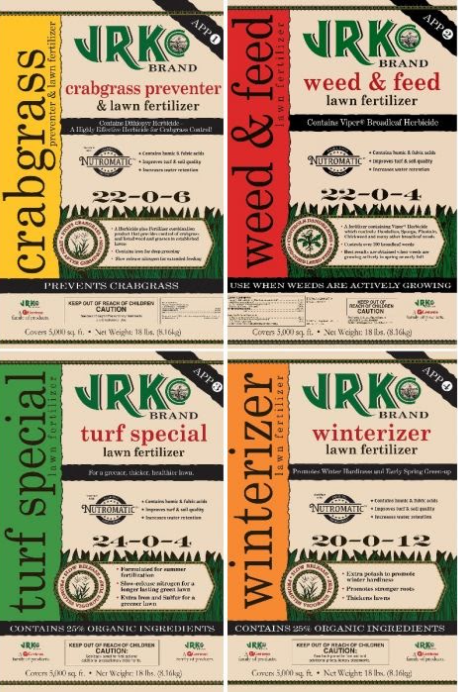There are two types of weed killer. Pre-emergent and Post-emergent. Apply a pre-emergent before you see weeds. Apply Post-emergent when weeds are actively growing and you can see them but before the real heat of summer arrives for best results.
Pre-emergent herbicides do not prevent the germination of the seed, but help control it so that it will not sprout. Due to the way herbicides work, application timing is the most important aspect of weed prevention success.
Prevention is key for Crabgrass. Click HERE to buy online. Always follow the directions on the package.
Pre-emergent instructions:
- Early spring (mid April to mid May) is the best time to apply a pre-emergent. Typically this is used for crabgrass control in our area. More complete information on crabgrass control is HERE.
Post Emergent Weed killers are a contact killer
Post Emergent Weed killers are a contact killer, they absorb the chemical through what comes in contact with the leaf surface and then translocates the chemical throughout the plant. Since weed killers are dependent on contact, it is very important to get good contact with the weed.
Post-emergent instructions:
- Apply weed killer (granular or liquid) around a predicted rainfall or sprinkler application, and severe hot days or mowing schedule.
- Granular weed killers should be applied when grass is damp and should not be watered for 48 hours after application. The dampness of the grass ensures the granular weed killer will "stick" to the leaf. Water applied too soon after application can wash off the weed killer before it can be absorbed.
- Don't mow the grass before applying weed killers. Plan to leave your grass uncut for five days before application and two days after.
- Stay off your lawn for one day after application.
NOTE: During drought conditions or if you are having trouble getting adequate control, add a spreader sticker (aka surfactant or wetting agent) which will increase absorption of the weed killer. Some of Gertens weed killers have a surfactant in them. Read the label. During stress periods, plants tend to be more defensive and the addition of surfactant can be beneficial. This type of chemical additive acts as a buffer, breaking up the surface tension of a liquid. In weed control products, they are used to help break down the plant’s resistance in absorbing the chemical being applied to it.
Gertens offers the easy JRK 4-step Program
JRK offers a 4-step program for complete lawn care through the seasons.
The experts at Gertensare always available to answer your questions!
List of weeds:
Comprehensive weed list from the University of Minnesota Extension
As an enthusiast with a deep understanding of weed control and herbicides, I've had extensive hands-on experience in horticulture and lawn care. Over the years, I've honed my knowledge by experimenting with various weed prevention and elimination methods, staying up-to-date with the latest research, and collaborating with experts in the field. My passion for maintaining lush, weed-free lawns has driven me to explore the nuances of pre-emergent and post-emergent herbicides, understanding their mechanisms and optimal application techniques.
Now, let's delve into the concepts presented in the article about weed killers:
-
Pre-emergent vs. Post-emergent Herbicides:
- Pre-emergent: These herbicides are applied before weed seeds germinate. They don't prevent germination but control the growth of the weed, ensuring it doesn't sprout. Timing is crucial for pre-emergent herbicides, and the article emphasizes applying them in early spring for optimal results, especially for controlling crabgrass.
- Post-emergent: These herbicides are applied when weeds are actively growing and visible. They work as contact killers, absorbing chemicals through the leaf surface and translocating them throughout the plant. The article suggests applying post-emergent herbicides around predicted rainfall or sprinkler applications and avoiding hot days or mowing schedules for better efficacy.
-
Pre-emergent Application Instructions:
- Best time: Early spring (mid-April to mid-May), specifically for crabgrass control.
- Follow package directions diligently.
-
Post-emergent Application Instructions:
- Apply around predicted rainfall or sprinkler application, avoiding severe hot days or mowing schedules.
- For granular weed killers, apply when grass is damp, and avoid watering for 48 hours. The dampness helps the granules stick to the leaf surface.
- Don't mow the grass five days before and two days after application.
- Stay off the lawn for one day after application.
-
Additional Tips:
- During drought conditions, or if control is challenging, consider using a spreader sticker (surfactant) to enhance weed killer absorption. Some products may already contain surfactants.
- Surfactants break down the plant's resistance, aiding in chemical absorption.
-
Gertens JRK 4-step Program:
- Gertens offers a comprehensive 4-step program for complete lawn care through the seasons.
-
List of Weeds:
- The article references a comprehensive weed list from the University of Minnesota Extension, providing valuable information on identifying and dealing with different weed species.
In conclusion, successful weed control involves a nuanced understanding of herbicide types, proper application timing, and adherence to specific instructions. Whether you're dealing with pre-emergent or post-emergent herbicides, a strategic approach is essential for maintaining a healthy and weed-free lawn.

